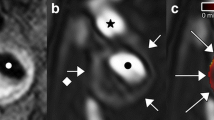Abstract
Non-invasive external magnetic resonance imaging (MRI) of large vessel atherosclerosis is a robust and promising imaging modality that can be applied for the evaluation of the atherosclerotic process in large vessels. However, it requires expertise for setup and time for data acquisition and analysis. Intravascular MRI is a promising tool, but its use remains at the pre-clinical stage within selected research groups. In this review, the current status and future role of intravascular MRI for atherosclerotic plaque characterization are summarized, along with important challenges which will be necessary to overcome prior to the wide adoption of this technique.





Similar content being viewed by others
Abbreviations
- 3T:
-
3.0 Tesla Magnetic Field Strength
- CT:
-
Computed tomography
- IVMRI:
-
Intravascular magnetic resonance imaging
- IVUS:
-
Intravascular coronary ultrasound
- MACE:
-
Major cardiovascular events
- MRI:
-
Magnetic resonance imaging
- OCT:
-
Optical coherence tomography
- SNR:
-
Signal-to-noise ratio
References
Papers of particular interest, published recently, have been highlighted as: • Of importance •• Of major importance
Libby P. Inflammation in atherosclerosis. Nature. 2002;420:868–74.
Stone GW, Maehara A, Lansky AJ, et al. A prospective natural-history study of coronary atherosclerosis. N Engl J Med. 2011;364:226–35.
Calvert PA, Obaid DR, O’Sullivan M, et al. Association between IVUS findings and adverse outcomes in patients with coronary artery disease: the VIVA (VH-IVUS in Vulnerable Atherosclerosis) Study. JACC Cardiovasc Imaging. 2011;4:894–901.
Niccoli G, Montone RA, Di Vito L, et al. Plaque rupture and intact fibrous cap assessed by optical coherence tomography portend different outcomes in patients with acute coronary syndrome. Eur Heart J. 2015;36:1377–84.
Balu N, Wang J, Dong L, et al. Current techniques for MR imaging of atherosclerosis. Top Magn Reson Imaging. 2009;20:203–15.
Underhill HR, Hatsukami TS, Fayad ZA, et al. MRI of carotid atherosclerosis: clinical implications and future directions. Nat Rev Cardiol. 2010;7:165–73. Excellent review highlighting the potential clinical applications of MRI to evaluate atherosclerosis.
Hussain T, Henningsson M, Butzbach B, et al. Combined coronary lumen and vessel wall magnetic resonance imaging with i-T2prep: influence of nitroglycerin. Int J Cardiovasc Imaging. 2015;31:77–82.
Varma N, Hinojar R, D’Cruz D, et al. Coronary vessel wall contrast enhancement imaging as a potential direct marker of coronary involvement: integration of findings from CAD and SLE patients. JACC Cardiovasc Imaging. 2014;7:762–70.
Andia ME, Henningsson M, Hussain T, et al. Flow-independent 3D whole-heart vessel wall imaging using an interleaved T2-preparation acquisition. Magn Reson Med. 2013;69:150–7.
Peel SA, Hussain T, Schaeffter T, et al. Cross-sectional and in-plane coronary vessel wall imaging using a local inversion prepulse and spiral read-out: a comparison between 1.5 and 3 Tesla. J Magn Reson Imaging: JMRI. 2012;35:969–75.
Hurst GC, Hua J, Duerk JL, et al. Intravascular (catheter) NMR receiver probe: preliminary design analysis and application to canine iliofemoral imaging. Magn Reson Med. 1992;24:343–57.
Martin AJ, Henkelman RM. Intravascular MR imaging in a porcine animal model. Magn Reson Med. 1994;32:224–9.
Correia LC, Atalar E, Kelemen MD, et al. Intravascular magnetic resonance imaging of aortic atherosclerotic plaque composition. Arterioscler Thromb Vasc Biol. 1997;17:3626–32.
Quick HH, Ladd ME, Zimmermann-Paul GG, et al. Single-loop coil concepts for intravascular magnetic resonance imaging. Magn Reson Med. 1999;41:751–8.
Zimmermann-Paul GG, Quick HH, Vogt P, et al. High-resolution intravascular magnetic resonance imaging: monitoring of plaque formation in heritable hyperlipidemic rabbits. Circulation. 1999;99:1054–61.
Ocali O, Atalar E. Intravascular magnetic resonance imaging using a loopless catheter antenna. Magn Reson Med. 1997;37:112–8.
Larose E, Yeghiazarians Y, Libby P, et al. Characterization of human atherosclerotic plaques by intravascular magnetic resonance imaging. Circulation. 2005;112:2324–31. First in vivo study demonstrating the feasibility of studying atherosclerosis plaque components using IVMRI.
Larose E, Kinlay S, Selwyn AP, et al. Improved characterization of atherosclerotic plaques by gadolinium contrast during intravascular magnetic resonance imaging of human arteries. Atherosclerosis. 2008;196:919–25. Study highlights the importance of intravenous gadolinium to facilitate the discrimination and plaque characterization evaluated in vivo by IVMRI.
Schneiderman J, Wilensky RL, Weiss A, et al. Diagnosis of thin-cap fibroatheromas by a self-contained intravascular magnetic resonance imaging probe in ex vivo human aortas and in situ coronary arteries. J Am Coll Cardiol. 2005;45:1961–9.
Sathyanarayana S, Schar M, Kraitchman DL, et al. Towards real-time intravascular endoscopic magnetic resonance imaging. JACC Cardiovasc Imaging. 2010;3:1158–65.
Qian D, Bottomley PA. High-resolution intravascular magnetic resonance quantification of atherosclerotic plaque at 3T. J Cardiovasc Magn Reson. 2012;14:20.
Achenbach S, Boehmer K, Pflederer T, et al. Influence of slice thickness and reconstruction kernel on the computed tomographic attenuation of coronary atherosclerotic plaque. J Cardiovasc Comput Tomogr. 2010;4:110–5.
Sinclair H, Bourantas C, Bagnall A, et al. OCT for the identification of vulnerable plaque in acute coronary syndrome. JACC Cardiovasc Imaging. 2015;8:198–209.
Author information
Authors and Affiliations
Corresponding author
Ethics declarations
Conflict of Interest
João L. Cavalcante and Eric Larose declare that they have no conflict of interest.
Human and Animal Rights and Informed Consent
This article does not contain any studies with human or animal subjects performed by any of the authors.
Additional information
This article is part of the Topical Collection on Cardiac PET, CT, and MRI
Rights and permissions
About this article
Cite this article
Cavalcante, J.L., Larose, E. Intravascular MRI for Plaque Characterization: Are We Close to Reality?. Curr Cardiol Rep 18, 89 (2016). https://doi.org/10.1007/s11886-016-0766-1
Published:
DOI: https://doi.org/10.1007/s11886-016-0766-1




